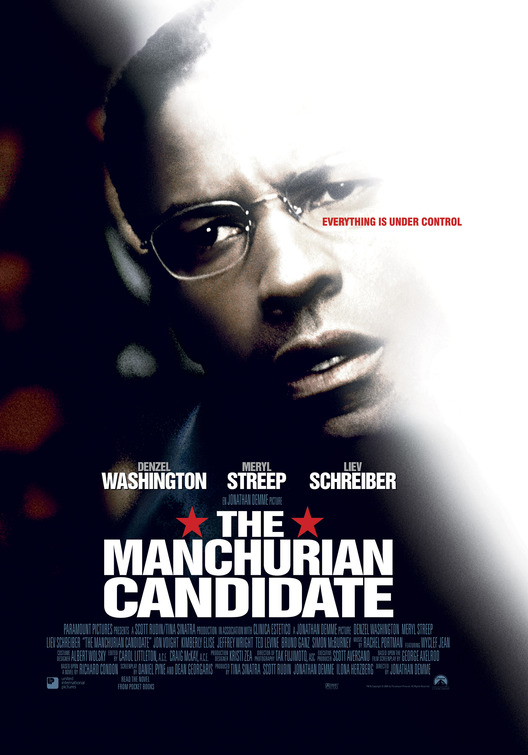 |
I recently watched Jonathan Demme's 2004 remake of THE MANCHURIAN CANDIDATE. I've seen the original 1962 version several times and it's a film I hold in high regard. The remake updates the basic plot with a few new wrinkles for the 21st century and is, generally speaking, a slick, well-made political thriller. But I have a major problem with the key plot device of the narrative and I'm going to have to discuss in detail the end of the film here in order to make my point. In the film, Bennett Marco (Denzel Washington), a veteran of the Gulf War, has been brainwashed to act as a political assassin. In the original film, Frank Sinatra played the part of Marco but he did not act as an assassin. That duty fell to Sgt, Raymond Shaw (Laurence Harvey). Here, Shaw, as played by Live Schreiber, is another war hero who is positioned to be the vice-presidential nominee on an unnamed political party's ticket. Meryl Streep plays Shaw mother's (Angela Lansbury played the part in the original), a U.S. Senator, who will stop at nothing to see her son propelled into a strategically vital political position. Shaw receives the nomination as vice president for his party at the convention and he's joined on stage by his mother. They stand alongside the presidential candidate whom Marco has been brainwashed into shooting. Instead, Marco overcomes his programming and shoots both Shaw and his mother with one bullet, effectively eliminating the real threat to the country. It's a neat twist ending but I'm left wondering, what was the point of Marco shooting the presidential candidate in the first place? We're only at a political convention. The men have just been nominated. The ticket hasn't won a general election and neither man has taken an oath of office and been sworn into their respective duties. So why shoot a presidential candidate at this stage of the campaign? Would Shaw automatically become the presidential candidate by default? Or would the delegates at the convention have to place into nomination another candidate for the position? Even if Shaw was somehow placed at the head of his party's ticket, it doesn't guarantee that he'll be elected in November. Wouldn't it make far more sense to wait until Shaw and the presidential candidate are elected and sworn in, before killing the new president? That's the only way I know of to put Shaw into office through a legal, constitutionally mandated succession of power. If anyone has any insight into this question, I'd like to hear from them. Sure it makes for great political theater and high drama to stage an assassination at a major convention but from a logistical point of view, if making sure that the brainwashed Raymond Shaw ends up in the highest office of the land, it just wouldn't accomplish that goal. Still, Demme delivers a well-crafted and very well acted film. Denzel Washington is superb as a broken man slowly uncovering the truth about his past, Schreiber is a stolid war hero, a blank slate upon which the evil schemes of others have been imprinted and Meryl Streep is almost-but-not-quite over-the-top as the power hungry mother who dominates her son in every way. As a rule, I don't think remakes are necessary. Certainly not in the case of this material. The original MANCHURIAN CANDIDATE was an excellent film, superbly directed by John Frankenheimer. It's very much a product of the Cold War era in which it was made. Demme's film doesn't make any noticeable improvements on the material, merely some cosmetic changes. The plot is still essentially the same. So, why spend all of that time, talent and money to redo something that was damn near perfect the first time? Couldn't all of that effort been put to good use on something new, fresh and original? The argument in favor of remakes like this used to be that the majority of today's moviegoers aren't familiar with the original, that it's an old movie in black and white with actors and actresses who are all dead and the material needs to be freshened up for a new generation. That may have been true at one point but it's not true any longer. Anyone of any age who has any interest has access to the original version of THE MANCHURIAN CANDIDATE. They don't have to wait to catch it on television or to see it at a revival house. In 2014, the 1962 MANCHURIAN CANDIDATE is a click away, ready to be downloaded or streamed wherever and whenever anyone wants it. So, the film is more accessible today than it has ever been. That eliminates the argument that today's audiences don't have access to the original film. The question (and problem) becomes, do they want to become familiar with it or will they prefer this new iteration which itself will probably be redone yet again in another twenty-odd years. All I know is that while Demme's film is well made and entertaining, I still prefer the original version. |
Tuesday, December 30, 2014
HERE THERE BE SPOILERS
Thursday, December 4, 2014
MAJIC MAN
 |
I finished reading MAJIC MAN by Max Allan Collins the other night. This 1999 mystery novel is the 11th Nate Heller adventure. The latest in the series, ASK NOT, was published 2013. Nate Heller, for those who don't know, is a private detective who gets involved in several of the most high profile real life murder/mystery cases of the 20th century. Throughout the series, Heller interacts with almost everyone who was anyone in America between the 1930s and the 1960s. Politicians, gangsters, movie stars, cops, government agents, presidents, cabinet members, newspaper columnists, military officers, etc. Heck, you name 'em and if they are in any way connected to a famous crime or unsolved mystery, Heller's met 'em. He's a gumshoe Forrest Gump investigating the seedy underbelly of the twentieth century in novels that are film noir meets The History Channel. I've read four of the Heller novels. The first, TRUE DETECTIVE was published in 1983 (I read it way back when). It involves the assassination attempt in Miami on President Franklin D. Roosevelt and Chicago's Mayor Cermak. BLOOD AND THUNDER (1995, Nate Heller #8) is about another political assassination, this one that of Louisiana governor Huey P. Long. And FLYING BLIND (1998, Nate Heller #10) reveals what really happened to legendary aviatrix Amelia Earhart. MAJIC MAN finds Heller involved with the near-mythic "flying saucer" crash that occurred in Roswell New Mexico in July 1947. The bulk of the novel takes place two years later, in 1949 with Heller interviewing as many witnesses to the "crash" as possible. The more people he talks to, the more it appears that there really may have been aliens involved in the incident. Or were they? Heller interacts with Secretary of Defense James D. Forestal, President Harry Truman, columnist Drew Pearson, Air Force officer Jesse Marcel and about a dozen other real people. He also discovers a secret organization within the U.S. government known as Majestic Twelve. The truth about Roswell is finally revealed but not before lives are lost. MAJIC MAN is a first rate page turner. Collins has done his homework well and he sticks to the historical facts of the case. His portrayals of real people are accurate, as are his descriptions of period clothes and cars. Heller wisecracks his way through a twisted case of government cover-ups, ex-Nazis, a beautiful femme fatale and more. If you love mysteries, if you love history, check out MAJIC MAN. You'll love it. I sure did. |
Tuesday, December 2, 2014
GOING CLEAR
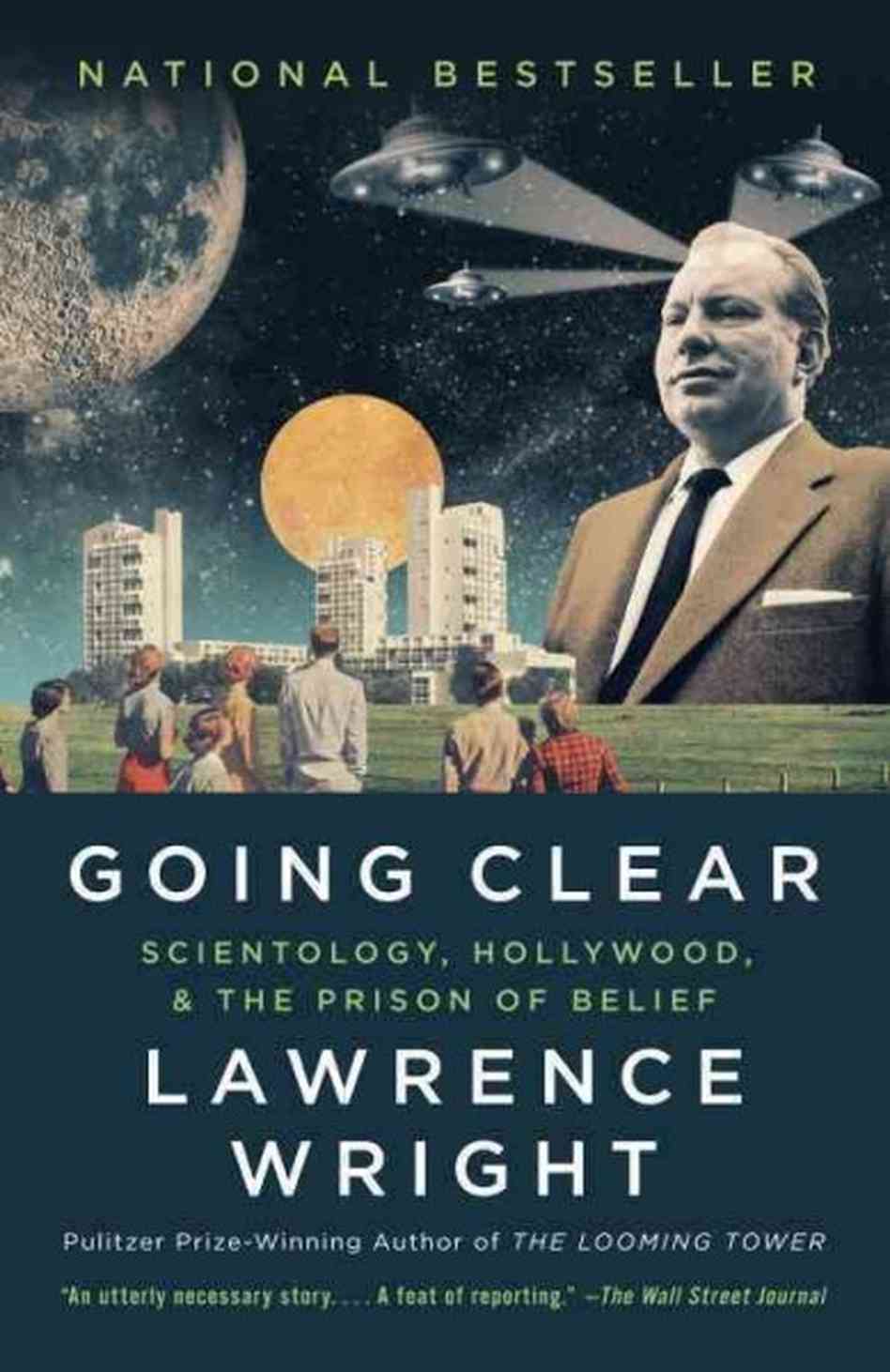 |
"I can't get with any religion that advertises in POPULAR MECHANICS"-Woody Allen, ANNIE HALL (1977) You didn't have to be crazy to be a pulp fiction writer in the early twentieth century but it didn't hurt if you were. Consider the life and career of Texan Robert E. Howard (1906-1936), creator of Conan the Barbarian and other sword and sorcery heroes. Howard was, by all accounts, crazier than a shit house rat but boy, that sum bitch sure could write. He's one of my all time favorite yarn spinners and it's a shame that he took his own life at the astonishingly young age of thirty. L. Ron Hubbard, another pulp writer, was apparently crazy too. Crazy like a fox. A prolific wordsmith of marginal talent, Hubbard hacked out (figuratively and literally) a career in the pulp jungle of the '30s and '40s. He wrote a few novels in addition to the hundreds of stories he churned out in a variety of genres. But Hubbard's career really took off when he wrote DIANETICS and subsequently founded the Church of Scientology. Scientology's "theology" is based on a story told by Hubbard that wouldn't have appeared out of place in the pages of the pulp science fiction magazine AMAZING STORIES. But this yarn along with other writings by Hubbard, became the basis for a worldwide church that is staggeringly wealthy and powerful. All of this and more is meticulously detailed in GOING CLEAR: SCIENTOLOGY, HOLLYWOOD & THE PRISON OF BELIEF (2013) by Austin based writer Lawrence Wright. I finished reading this one about a month ago and it's one helluva read. Wright, a Pulitzer Prize winner for THE LOOMING TOWER (2006), bends over backwards to present as fair and balanced a portrait of Hubbard and Scientology as possible. He conducted dozens of interviews and offers a revealing peek behind the scenes of this highly secretive religion. What emerges in the pages of GOING CLEAR is the story of Hubbard, who appears to have been a pathological liar and control freak with delusions of grandeur. Those delusions were ultimately fulfilled however by the creation of his church of Scientology which brought him untold wealth and power. Scientology comes off as a group of not-so nice people doing extremely questionable things. The leaders of the church seem obsessed with courting such Hollywood stars as John Travolta, Kirstie Alley and, most importantly, Tom Cruise. Having a big name actor serve as the public face and spokesperson for Scientology seems to lend an air of credibility and respectability to the church and the leadership will go to any extremes to keep Tom Cruise front and center. And happy. The leadership also indulges in punishing members for mistakes, subjecting them to treatment that some frat houses wouldn't condone during pledge week. Members are made to suffer and suffer some more when they don't pass their "audits". The church is also extremely vindictive and litigious when it comes to any negative portrayal in the media. The church leadership has filed countless law suits against their "enemies" and have resorted to other strong arm tactics including blackmail and coercion. Criminal acts and terroristic behavior abound in the pages of GOING CLEAR. Wright and a small army of attorneys (most of them from THE NEW YORKER magazine) faced off against the current church leader David Miscavige during the writing of this book. Screenwriter and director Paul Haggis, who spent years in Scientology, is now out of the church and served as one of Wright's main sources of information. There are many other people, former church members, who speak out in the book as well. GOING CLEAR is a fascinating book. It reveals everything you ever wanted to know about Scientology and then some. It's not a pretty picture although, to be fair, many people have benefited from the religion over the years. It's the people who have been abused by the church that make up this extremely compelling, eye-opening, page turner of a history of a man and his followers. GOING CLEAR was a finalist for the National Book Award for Nonfiction and was shortlisted for the 2013 National Book Critics Circle Award. The book is currently being adapted into a documentary by HBO and is slated for release at the Sundance Film Festival in 2015. HBO had 160 lawyers review the film out of fear of litigation by the Church of Scientology. |
Sunday, November 30, 2014
GUNS AT BATASI
 |
I watched GUNS AT BATASI (1964) for the first time the other day and enjoyed it. Although the DVD copy I have is from the 20th Century Fox "War Movies" collection, it's hard to classify this film as an actual "war" movie. It does involve military forces and armed conflict but it's not set during any actual historical "war". The story takes place in an unnamed African country during the then present day (1964). The country has recently been granted its' independence from Great Britain. There's a provisional government in place and British troops are still in country, training the natives to serve in what will eventually become their own national military. But the situation is fraught with tension. A revolutionary group stages a coup against the brand new government. There are supporters of this group within the military and they soon seize control of the military base at Batasi. They order the British soldiers there to surrender their weapons and stand down. And that's when things take a turn for the worse. A British Sergeant Major (superbly played by Richard Attenborough) refuses to back down. He's been posted to British colonies and military bases around the globe over the course of his military career but he's never been in a combat situation. He sees the current situation as a chance to uphold his military training and loyalty to the crown and, just possibly, to cloak himself in the glory of battle. Attenborough and his men (a small handful of other officers) use their officer's club as a fortress against the rebels who eventually issue an ultimatum: surrender their weapons or be killed. To show that they mean business, the rebels bring in two giant cannons and point them at the building. Against a ticking clock, Attenborough and one of his men sneak out and blow up the guns only to find out that everything has been resolved between the new, revolutionary government and the British foreign office. Peace is restored but Attenborough is transferred back to England due to his insubordination. GUNS AT BATASI is an intelligent, well written (Leo Marks, Marshall Pugh and C.M. Pennington-Richards adapted the novel Siege of Battersea by Robert Holles) drama. Director John Guillermin keeps things moving and slowly ratchets up the tension between the British officers and the rebel soldiers. He gets good performances out of a solid cast which includes Jack Hawkins, Flora Robson and Mia Farrow. Although set in Africa, GUNS AT BATASI was filmed entirely in England. A great deal of the "action" takes place indoors with scenes in the embattled officers' club having an air of claustrophobic unease and dread. A minor film but a good one. Thumbs up. |
Thursday, November 27, 2014
BADLANDS
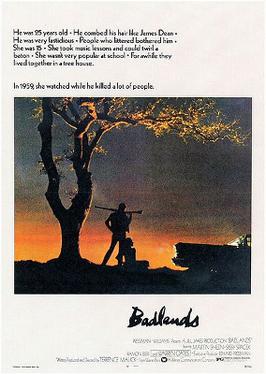 |
Well, I'm glad I finally got that out of my system. Until a few nights ago, I'd never seen a Terence Malick film. The mercurial (and sometimes Austin resident) filmmaker has a reputation for making beautifully shot, incredibly cerebral films. He also rivals the legendary Stanley Kubrick for producing a small body of work over an extremely long period of time. Consider his filmography: BADLANDS (1973), DAYS OF HEAVEN (1978), THE THIN RED LINE (1998), THE NEW WORLD (2005), THE TREE OF LIFE (2011), TO THE WONDER (2012) and KNIGHT OF CUPS (2014). That's seven films over a forty year span. I finally watched my first (and most likely, last) Terence Malick film the other night. BADLANDS ran on TCM and I recorded it and watched it. I'm not certain of this, but I'm willing to bet good money that some 1973 film reviewer used the words "lyrical, poetic" in his or her review of BADLANDS. "Lyrical, poetic" in a film review are code words for "has no plot". BADLANDS has a plot (sorta). It's a beautifully shot film (three cinematographers worked on the film: Tak Fujimoto, Stevan Larner and Brian Probyn), well acted (the young Martin Sheen and even younger Sissy Spacek are both very good), glacially paced film about two young lovers/killers on the run in the 1950s. Except that there's no dramatic tension, no sense of urgency, no blackly comic buzz to the whole affair. BADLANDS goes nowhere and takes it own sweet time in getting there. You want a good young lovers/killers on the run film? Check out THEY LIVE BY NIGHT (1948), GUN CRAZY (1950), BONNIE AND CLYDE (1967) or THE SUGARLAND EXPRESS (1974), any one of which is infinitely better than BADLANDS. Based on the true story of Charles Starkweather and Caril Ann Fugate in 1958, Martin Sheen channels his inner James Dean into his portrayal of Kit, an insane young man who kills several people throughout the course of the film, all for no apparent reason. Kit is no thief who kills in the commission of his crimes. He's a thrill killer without the thrill. Spacek is Holly, a borderline retarded young woman who accompanies Kit on his cross country spree after he shoots her father (the great Warren Oates, who is sadly under used here). The two live a fairy tale existence for awhile, setting up a tree house in the woods where they become a Swiss Family Robinson style little family. But the law soon stumbles upon them, Kit shoots and kills the police officers and they're on the run again. They're eventually captured. Kit is executed, Holly receives probation. As I said, the film is gorgeous to look at and well acted but that's about the only nice things I can say about BADLANDS. It's a pretentious art film and I hate pretentious art films. I don't think I'll bother to see any other Malick films. I'll add him to my list of filmmakers to avoid along with David Lynch and Quentin Tarrantino. Thumbs down. |
Thursday, November 20, 2014
AIR RAID WARDENS
Wednesday, November 19, 2014
OFF TO A GREAT START
Sunday, November 16, 2014
"SEE ME. HEAR ME."
 |
This coming Tuesday evening, November 18th, at 7:00 p.m., I'll be introducing a screening of THERE'S NO BUSINESS LIKE SHOW BUSINESS (1954) at the newly re-opened, one-hundred-year-old Hippodrome Theater in Waco, Texas. A talkback will follow after the screening. The Hippodrome website says I'm a "film scholar." I like the sound of that. This is the first of many classic film screenings scheduled at the Hippodrome. Coming up (dates to be confirmed) are THE CIRCUS (Charlie Chaplin) and the first three original STAR WARS films ( A NEW HOPE, THE EMPIRE STRIKES BACK and THE RETURN OF THE JEDI). More will be announced shortly but those are the ones that I've written film notes for. I had my first meeting with Melissa Green, programmer for The Hippodrome, back in June. I agreed to write film notes for any and all classic films they screen and to provide introductions and talkbacks on an occasional basis. I haven't written about this until now because I wanted to wait until everything was official and the theater was actually open for business. The Hippodrome has plans to be Waco's home-grown version of Austin's venerable Alamo Drafthouse Cinemas. In addition to the occasional classic film, the Hippodrome will play first run feature films, live music, theater (including the Pollyanna Theater Company's production of LIBERTY! EQUALITY! AND FIREWORKS!), etc. The plan is to have something happening every night of the week. The theater has two performance venues, the main theater on the ground floor and an enclosed, more intimate balcony theater on the second level. There's also a full bar and restaurant. I'm thrilled to be a part of the rebirth of this piece of Texas movie theater history. If you're in the Waco or Central Texas area and want to see a classic film along with yours truly, go to http://wacohippodrometheatre.com/events to purchase tickets and for more information. |
Thursday, November 13, 2014
SHADOWED MILLIONS
.jpg) |
1933 got off to a great start with the publication of SHADOWED MILLIONS by Maxwell Grant (the house name that Shadow creator and chief scribe Walter Gibson worked under) on January 1st. It was the 21st published adventure of the pulp crime fighter. That's the 1970s paperback reprint pictured above, published by Pyramid Books and sporting a gorgeous cover by master comic book artist Jim Steranko. I finished reading this book last night and it's a corker. Alvarez Legira, consul of the newly created South American republic of Santander, comes to New York City to acquire ten million dollars from a group of wealthy financiers and investors. Ten million dollars is a hell of a lot of money in 2014. In 1933, it was an absolutely astronomical sum. Legira secures the loan but it's not clear if he will use the money to boost his country's economy or if he plans to abscond with all of it for himself. Crooks get wind of the deal and start maneuvering to cut themselves in for either a piece of the action or the entire amount. Legira hires a look-a-like to throw off the bad guys but it's too little, too late. Murders occur and Legira is forced to go into hiding with the money while he waits for a boat to arrive off of the coast of Long Island. Of course, The Shadow is mixed up in all of this and he races against the clock to prevent a criminal mastermind from stealing the money. There's a terrific gun battle in the third act, followed by a hell-and-gone car chase and shootout before the final showdown aboard a yacht where The Shadow engineers a masterful switcheroo. SHADOWED MILLIONS is fast paced and fun. It's far from the greatest Shadow novel ever written but it's a good one nonetheless. Thumbs up. |
Friday, November 7, 2014
SYRI-YAWN-A
It' s beautiful fall day. Too beautiful to waste it watching SYRIANA (2005). I gave this film one hour and turned it off. I had no idea what was going on in this convoluted and snail paced "thriller". Something to do with a merger between two American oil companies, middle east terrorists, a CIA assassin and an investigation by the U.S. Justice Department. George Clooney won a Best Supporting Actor Oscar for his portrayal of a CIA operative. I kept watching, thinking that any minute now, in the next scene maybe, surely the pieces of this puzzle will start to come together and make sense. Are any of these various characters ever going to meet? Do any of the multiple storylines ever converge? Who cares? SYRIANA is an unmitigated mess of a film and it's hard to believe that it got made with such high profile talent attached to it. I can usually make it through even the worst of movies (and lord knows, I've watched a lot of low budget trash over the years) until the bitter end but this? A major motion picture from a big Hollywood studio? Absolutely impossible to figure out what's going on and where the story (if you can call it that) is headed. I'm going outside for some fresh air. |
Saturday, November 1, 2014
WIZARD WORLD AUSTIN COMIC CON 2014: PRO AND CON
 |
Let me begin this piece by saying that I scored some very cool books (and an action figure!) at the recent Wizard World Austin Comic Con. Those treasures have all been posted here over the past month and I am quite pleased with everything I bought. And, as related in another post, getting to and from the convention was easy thanks to Metro Rail. However, I have several criticisms of the overall convention experience, enough so that I honestly don't know if I'll attend another one. To begin with, for some reason the con this year ran Thursday, Friday and Saturday, which is very unusual. All previous Wizard World conventions have been Friday-Sunday affairs. My guess is that this scheduling must have been due to the availability of the Austin Convention Center but it's still a strange schedule. I bought my one day pass for Friday, so I was there on day two of the three day event. The convention website didn't post a schedule of panels until the week before the event. Again, I'm sure that several last minute things had to be nailed down and commitments from convention guests had to be confirmed but I would have liked to have seen this information posted earlier if possible. That said, there were two panels on Friday that I decided to attend first before hitting the dealer's room. The first was a celebration of Marvel Comics' 75th Anniversary. There were three people on the panel: former Marvel editor/writer Danny Fingeroth, my pal Alan Porter and some guy whose name I don't recall. I don't why Alan and the unknown panelist were up there because they added nothing to the event which consisted of a PowerPoint presentation narrated by Fingeroth. Fingeroth spent a great deal of time on the golden and silver age days of Marvel, so much so that he had to rush through the last 25 years of the company in about five minutes. Fingeroth provided no insights into what the company was like during his days on staff (which I would have loved to hear). He talked, the other two guys threw their two cents in occasionally and I didn't learn a single thing I didn't already know about the history of Marvel Comics. Not a great panel by any stretch but it was far better than what followed. The next "panel" (actually a one-woman show) was in the same room so I stayed put to see and hear something entitled "From Science Fiction to Science Fact". The woman presenting the material never identified herself to the audience so I have no idea who she was or what her credentials were. Was she a science fiction author? A scientist? A science writer? A futurist? No clue. Her presentation was another PowerPoint slide show of various technologies that are either already in existence or in development. It was like reading an issue of POPULAR SCIENCE with an ill-informed narrator. I got the impression that this woman had simply surfed the web for various science sites, found some interesting material and put it all together. Anyone could have done this. Her final "slide" was a plug for her various self-published science fiction books were for sale in booth number 1234. I doubt many people left that "panel" and made a beeline for her booth. In fact, many people bailed out of the presentation as this woman droned on and on and folks realized that they all had better things to do. I stayed until the end and wished I hadn't. One mediocre panel and one bad presentation down with the rest of the day to go. Time to hit the dealer's room and see what treasures I could find. The first thing I did was reconnoiter the whole exhibit hall and identify the booths I wanted to come back and hit on a second pass. To the left of the hall was the autograph and photo ops section. The main, center part of the hall was where the dealer's booths were located with "Artists Alley" at the rear of the space. In the center of the dealer's space and taking up an sizable piece of expensive Comic Con real estate was Neal Adams. Adams was at the convention last year and I bought a Superman print from him. He signed it for me and I have it framed and hanging in the man cave. I didn't particularly want to purchase another item from Adams this year but it was nice to see him again. The right side of the hall featured interactive exhibits, games and a space for people to play Magic The Gathering and other role playing games. So, something for everybody with cos players everywhere. I traversed the entire exhibit hall in about 30 minutes. Had I missed something? I covered the dealer's area again just to make sure and I was right the first time. There were almost no comic book dealers at the show. Oh, there were tons of other stuff. You want swords? Several booths had them along with light sabers, prop replicas of guns, T-shirts, art prints, high-end, autographed collectibles, action figures, toys, bobble heads, steam punk paraphernalia, bootleg DVDs (how do those guys get away with selling clearly illegal merchandise at these shows?), the current "hot" comics and more including a booth selling sugar gliders (who comes to a comic book convention to buy a live animal?), several "spin-and-win" movie passes booths, a booth for the Gay Geeks of Central Texas and State Farm Insurance. Wait, what? State Farm Insurance? What I didn't see was very many booths offering vintage comic books, magazines and toys for sale. For instance, at last year's Wizard World, legendary comic book dealer Mile High Comics had an enormous set up with literally thousands of comics old and new for sale. They weren't here this year and I suspect there are two reasons for that. One, the big New York Comic Con was coming up and they probably decided to spend their money on that show instead of Austin. And two, that they didn't have strong enough sales in Austin last year to warrant coming back. There were other big comic book dealer booths that were at the con in 2013 but they were all missing in action this year. I counted about half a dozen booths offering back issue comics and I decided to hit them all and ask for what I was looking for. My holy trinity of wants this time around were Dell and Gold Key comics, men's adventure magazines and pulp magazines. You've seen the Dell and Gold Key comics I was able to find. No one had any men's adventure comics and only one dealer had any pulps (four overpriced issues of WEIRD TALES). Granted, I'm at the far end of the collector spectrum, a 58-year-old man with specific interests that aren't "hot" and popular with the younger buyers. Heck, most kids probably don't have a clue about the type of material I was looking for. I also get that booths are expensive and that dealers have to bring what they think they can sell in order to cover their costs and make a profit. They are business people and I respect that. But I found it somewhat distressing that so few comic books of any kind could be found at a convention with the word "comic" in it's name. Everything else pop culture was well represented. State Farm Insurance was represented. Sugar gliders were there. But comic books? Good luck finding 'em at Wizard World Austin Comic Con. |
Friday, October 31, 2014
WIZARD WORLD AUSTIN COMIC CON TREASURES: THE FINAL CHAPTER
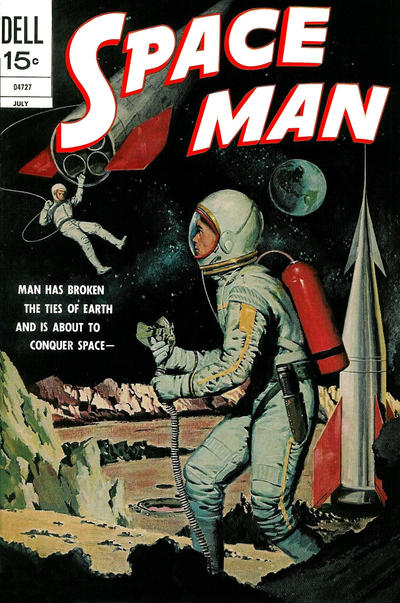 |
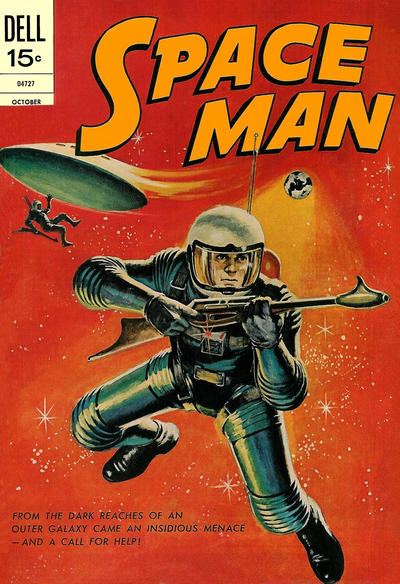 I've saved the best for last. The two beauties pictured above were the last books I bought at the recent Wizard World Austin Comic Con. They are SPACE MAN #9 from July 1972 (top) and SPACE MAN #10 from October 1972 (bottom). SPACE MAN was published by Dell Comics and debuted in FOUR COLOR COMICS #1253 in 1962. He received his own title (beginning with issue #2) in May of that year. The series ran nine issues (#2-10) ending in October 1972. Issue #9 reprints FOUR COLOR COMICS #1253 while #10 reprints SPACE MAN #2, so I effectively have the last two issues and the first two issues of this series. These books are in gorgeous condition. The covers really pop and my lovely wife Judy thinks I should have them framed and hung on the wall of my man cave. That's not a bad idea. As mentioned above, these were the last two books I bought at the con. I stopped at a booth with comics for sale and asked the dealer if he had any Dell and/or Gold Key comics for sale. "I've got two of them right here," he said, immediately going to a long box where the two issues of SPACE MAN were. "They're the only ones I brought." He wanted $25.00 apiece for them. I asked him if he'd take $20.00 each. "Cash?" he asked. "You bet, " I replied. "Deal." I gave him the money and walked away with two really cool comics at a fair price. If the dealer had brought more material like this, I would have certainly spent more money with him but as is, I'm thrilled to have these books. |
Wednesday, October 29, 2014
TSUI HARK'S VAMPIRE HUNTERS
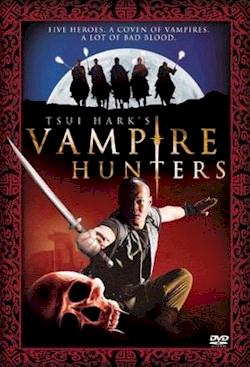 |
I was first introduced to the cinema of Tsui Hark in the late 1980s when my buddy Kelly Greene and I saw the Hong Kong sword and sorcery/fantasy/action/adventure film ZU WARRIORS FROM THE MAGIC MOUNTAIN (1983) sometime in the late 1980s at the long gone but never to be forgotten Dobie Theater. We were both blown away by the over-the-top, wildly choreographed and orchestrated sword fights, martial arts battles and the utterly baroque and bizarre visual style of the film. Did it all make any sense? Hell no. Did we love it? You betcha. Tsui Hark, who graduated from the University of Texas in 1975 (I enrolled there in 1974 so we were on campus at the same time), began his career as a Hong Kong filmmaker in 1979 with THE BUTTERFLY MURDERS. He's still making films today with his latest production, THE TAKING OF TIGER MOUNTAIN, released this year. In between, he's produced an astonishing body of work as a director, writer and producer of some of the greatest Hong Kong action films ever made. Kelly and I saw Hark's PEKING OPERA BLUES (1986) and his magnum opus ONCE UPON A TIME IN CHINA (1991), ONCE UPON A TIME IN CHINA II (1992) and ONCE UPON A TIME IN CHINA III (1993). What, no ONCE UPON A TIME IN CHINA WALKS AMONG US? Hark and fellow Hong Kong filmmakers John Woo and Ringo Lam formed a holy trinity of action directors whose films ranged from modern day shoot-em-ups to sword and sorcery fantasias set in distant worlds and times. These films began to make their way to the U.S. in the late '80s and early '90s and when they landed in Austin, they were screened at either the Dobie Theater or on the UT campus at either Hogg Auditorium or the Texas Union theater. Kelly and I made a point of seeing as many of these films as we could. We became instant fans of this bold, brash, go-for-broke style of cinema. It was something fresh, new and invigorating and we loved almost every film we saw. I often thought that discovering those Hong Kong films in the late '80s and early '90s was akin to what film fans must have experienced in the '60s when the Italian made Spaghetti Western films hit urban cinemas across the nation. Tsui Hark himself was on hand in a UT classroom following the screening of one of his films and for the life of me, I cannot remember which one it was (Kelly, when you read this, if you remember the film, help me out). I do recall that Kelly and I attended the screening and then hustled over to the building where Hark was scheduled to hold court. I remember him being a short, slender man who was very gracious and patient with his fans and the multitude of questions and comments we all had to offer. I found a copy of TSUI HARK'S VAMPIRE HUNTERS in a thrift store the other day for a buck. I hadn't seen a Hong Kong action film in many years and I figured it would be fun to revisit this genre that I found so richly rewarding those many years ago. Besides, the price was right. Tsui Hark is credited with writing and producing VAMPIRE HUNTERS (released in Hong Kong as THE ERA OF VAMPIRES) while the directing credit goes to Wellson Chin. It's not as good as 100% Hark but it's a serviceable exemplar of the kind of horror/action/comedy film that could only be made in Hong Kong. Yes, there are vampires in this film, but they're vastly different than the kind found in European and American films. There are also zombies (and a zombie wrangler to boot!). The plot concerns four young warriors and their ancient mentor who devote themselves to battling the undead wherever they find them in 17th century China. There's plenty of sword fights, marital arts battles,and bodies spin through the air courtesy of some good-but-not-great wire work. There are pretty girls, blood and guts and a few laughs here and there. But it's far from the greatness of the early Hark masterpieces. Maybe if the master himself had directed it, VAMPIRE HUNTERS would have been a better film. As it is, it's a fun movie and I enjoyed spending an afternoon with a celluloid friend whose acquaintance I'd missed over the years. If you're a fan of Hong Kong cinema, check out TSUI HARK'S VAMPIRE HUNTERS. If you're a newcomer, you might want to start with some of the earlier films listed above before watching this one. You'll enjoy it more with some experience and exposure to the wild, wild world of Hong Kong action films under your belt. |
Tuesday, October 28, 2014
HUSBANDS AND WIVES
 |
I watched Woody Allen's HUSBANDS AND WIVES (1992) for the second time the other day. The first time I saw this film was when it was released in 1992. I don't recall liking the film very much at that time but when I watched it again last week for the first time in twenty-two years, I found it to be a singularly unpleasant film. It pains me to write that about a Woody Allen movie. While I haven't seen all of his films, I've seen a lot of them and for a long stretch of years, I made it a point to see every new Allen film in the theater upon its' release. I stopped doing that several years ago and I've missed most of his output of the last dozen or so years. I'm sure I've missed some great films. I'm equally sure I've missed some bad ones. It's the law of averages. When you write and direct a new movie every year for the past 40+ years as Allen has, you're bound to hit an occasional home run every now and then just as you're bound to strike out every so often. HUSBANDS AND WIVES is one big swing and a miss. The film focuses on two married couples, Gabe and Judy Roth (Woody Allen and Mia Farrow, respectively) and Jack and Sally (Sydney Pollack and Judy Davis). At the beginning of the film, Jack and Sally announce to Gabe and Judy that they are separating. This bit of news causes some uneasiness to come between Gabe and Judy. Jack soon takes up with Sam (Lysette Anthony), a young, blond bimbo, while Judy plays matchmaker for Sally by introducing her to Michael (Liam Neeson), a handsome young graphic designer. The trouble is, Judy is secretly in love with Michael and wants the budding relationship between the two to fail. Meanwhile, Gabe, who teaches writing at Columbia University, becomes enamored with one of his young students, Rain (Juliette Lewis). He thinks she has real talent as a writer and he shows her the manuscript he's been working on. Rain, it turns out, is some kind of magnet for older men, with a series of affairs under her belt. In the end, Jack and Sally get back together. Gabe and Judy divorce. Judy and Michael get married. Gabe is tempted to sleep with Rain but resists the urge. He's left alone, the odd man out, at the end of the film. My problems with the film are many. To begin with, Allen shoots everything with a handheld camera that's constantly in herky-jerky motion. In almost every scene, his camera whirls around rooms and open spaces, darting here, zooming there, sometimes focusing on the character that's speaking, sometimes leaving them off screen. There are also multiple quick, jump cuts within scenes. All of this visual hugger mugger is, of course, meant to reflect the inner states of the characters. They're in turmoil over the disruptions their lives and relationships are undergoing. But the effect is tiresome and wearying after a very short while. To make matters worse, Allen does lock down his camera for scenes where the main characters address the camera straight on as subjects being interviewed by an unseen documentary film maker. Who this person is and why he wants to document the lives of such screwed up, morally reprehensible characters, is never explained. It's a narrative device that gives Allen (and the audience), a chance to catch our breaths from the visual roller coaster and let the characters have their say about their situations and philosophies. The three main women in the film, Farrow, Davis and Lewis, are all, to my eye, aggressively unattractive. I've never understood Allen's attraction to Farrow and Judy Davis, while a talented actress, is far from attractive. Juliette Lewis has a larger forehead than Paul Begala and is ready made to play the part of Exeter in a remake of THIS ISLAND EARTH. I've always thought Lewis gives off a major skank vibe in every film I've seen her in. HUSBANDS & WIVES contains very few laughs. Allen doesn't leaven the marital train wrecks on display with much humor. There are some jokes, but they're not good or memorable ones. Surprisingly, HUSBANDS & WIVES received two Academy Award nominations: Best Supporting Actress (Davis) and Best Original Screenplay (Allen). Neither one won an Oscar but the film did receive much critical acclaim at the time. Go figure. Finally, HUSBANDS & WIVES, is yet another Woody Allen film about extremely successful, uber-neurotic New Yorkers who lead such insular lives that it's hard to relate to any of the characters as real people. The themes of adultery, marital infidelity, failed relationships, unfulfilled desires and thwarted passions, are once again front and center. Allen seems obsessed with this material along with his increasingly creepy attraction to younger women. Hey Woody, if you're going to have a relationship with someone younger than you, at least pick someone better looking than Juliette Lewis. I still admire Woody Allen. Films such as ANNIE HALL, MANHATTAN and HANNAH AND HER SISTERS, rank as some of my all-time favorite movies. He is truly one of the great American filmmakers of both the 20th and 21st centuries. But he can't produce a masterpiece every time. HUSBANDS & WIVES is a stinker. |
WIZARD WORLD AUSTIN COMIC CON TREASURES 10
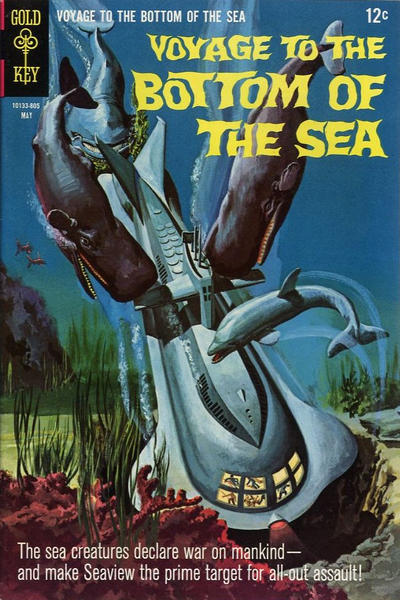 |
I scored a nice copy of VOYAGE TO THE BOTTOM OF THE SEA #12 (May, 1968) at Wizard World. This is one of several nice Gold Key books I got at a nice price from a very friendly dealer. Based on the ABC-TV series of the same name, VOYAGE TO THE BOTTOM OF THE SEA ran for 16 issues beginning in December 1964 and ending in April 1970. It outlived the Irwin Allen produced television series by a couple of years. VOYAGE TO THE BOTTOM OF THE SEA premiered on ABC on September 14th, 1964 on Monday night. It moved to Sunday night for the second season and remained there until September 1968. The first season episodes were broadcast in black and white while all subsequent episodes were in color. I have the complete Season One on DVD as well as the feature film that the series was based on. VOYAGE was one of my favorite TV shows when I was a kid. It started out as a fairly straightforward science fiction adventure series with some elements of espionage and intrigue. By the time it was over, it had become a "monster-of-the-week" show with the underwater monsters becoming more and more ludicrous. Still, I loved it and I love the comic books based on this fondly remembered program. |
Friday, October 24, 2014
WIZARD WORLD AUSTIN COMIC CON TREASURES 9
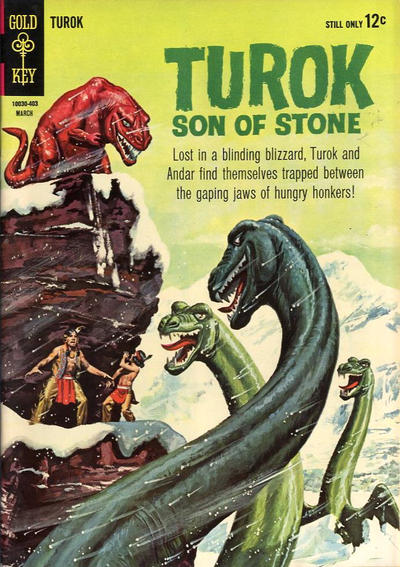 |
At the recent Wizard World Austin Comic Con, I stopped into a very small, cramped booth where a guy was selling vintage comics. He didn't have a very large inventory but I figured it was worth a try. "Got any Dell or Gold Key comics?" I asked. "I've got an issue of TUROK. Want to see it?" That exchange is verbatim and it's fascinating (and slightly troubling). One, the guy knew his stock. He knew he had exactly one issue of TUROK SON OF STONE in one of his long boxes and he knew exactly where it was. And it was the ONLY Dell or Gold Key comic he had for sale. The only one! He apologized for not having more of the comics I was looking for. "I've got more of those at my shop but space is limited, booths are expensive and I've got to bring what I know, or think I know, will sell," he explained. I bought the comic, of course. If he'd had more Dell and Gold Key titles, I would have bought more. But this beauty, TUROK SON OF STONE #38 from March, 1964 is now mine. I was nine-years-old when this issue hit the stands. I don't recall buying it then but I did buy TUROK on a semi-regular basis. It's one of my all-time favorite comic book series. My inner nine-year-old kid still loves the concept of American Indians and dinosaurs thrown together in a lost world. Great stuff! |
Thursday, October 23, 2014
MAJOR WEST, MEET MAJOR WEST
The year was 1965. The network was CBS. The month was September. On Wednesday, September 15th at 6:30 p.m. Central Time, LOST IN SPACE premiered. Among the cast was Mark Goddard who played Major Don West. Then, two nights later, on Friday, September 17th and also at 6:30 p.m. Central, THE WILD, WILD WEST debuted with Robert Conrad in the title role as Major James West. It's fun to imagine that perhaps the worlds of THE WILD, WILD WEST and LOST IN SPACE were somehow linked with Major Don West being a descendant of Major James West. Oh, and let's not forget HONEY WEST starring Ann Francis which also debuted on Friday, September 17th on ABC-TV at 8:00 p.m. Central. Maybe she was also a member of the television West family. Thanks for playing TV Trivia Time. We have some lovely parting gifts for you and our fabulous home version for you and your family to enjoy. See you next time! |
Monday, October 20, 2014
WIZARD WORLD AUSTIN COMIC CON TREASURES 8
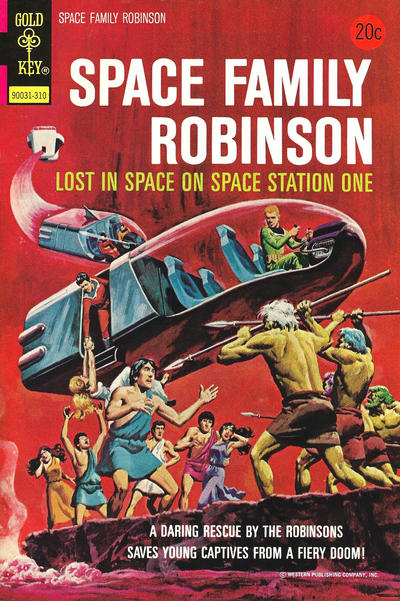 |
SPACE FAMILY ROBINSON #37 from October, 1973. This science fiction series began in December, 1962 and lasted 49 issues before ending in October 1976. The "Lost in Space" tag line was added to the title when the Irwin Allen television series of the same name debuted on CBS TV in 1965. The comic book and the TV show had one main similarity: a family named Robinson that was lost in space. But the "lost" Space Station One in the comics was radically different than the Jupiter 2 on television and in the comics, there were only four Robinsons (dad, mom, son & daughter) and none of the supporting cast found on television. Gotta admit I much preferred the comic book version with brilliant, bold painted covers like this one and the always superlative interior artwork by the great Dan Spiegle over the campy, juvenile and just plain stupid television show. This is one of several nice Gold Key comics that I bought for five bucks apiece from one dealer at the recent Wizard World Austin Comic Con. Great comics, great prices. Can't beat that. |
Sunday, October 19, 2014
WIZARD WORLD AUSTIN COMIC CON TREASURES 7 OR THE ADVENTURE OF THE HIDDEN COMIC BOOK
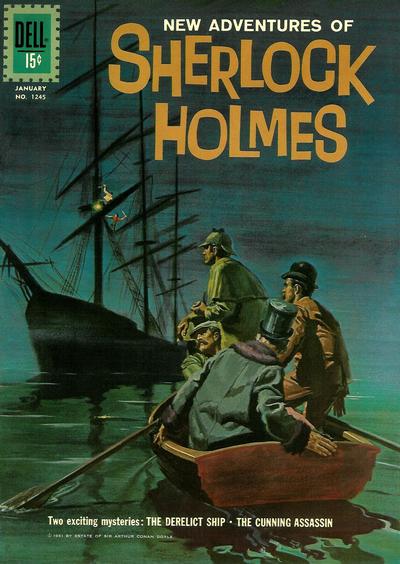 |
Pictured above is DELL FOUR COLOR COMICS #1245 featuring THE NEW ADVENTURES OF SHERLOCK HOLMES. This issue was published in late 1961 and it's the second appearance of the durable sleuth in the long running Four Color series. I scored this beauty at the recent Wizard World Austin Comic Con but finding it took some time and effort. Allow me elucidate Watson. I stopped at one of the few comic book dealer booths I could find at the convention. There was a nice, friendly guy behind the table and behind him was a wall display of comics. Along the bottom row were some Dell and Gold Key comics that caught my eye. I couldn't get to them though because the entrance to the interior of the booth was blocked by a table full of long boxes. I asked the guy if I could please see the books that had caught my eye and he politely complied. The books I examined were an issue of Gold Key's HANNA-BARBERA SUPER TV HEROES, a Gold Key issue of SUPERCAR and a Dell issue of THE ANDY GRIFFITH SHOW. HB SUPER TV HEROES had a price tag of $75.00, too rich for my blood. SUPERCAR had a price tag of $75.00 also. Again, a nice looking book and one I'd certainly like to have but not at that price. THE ANDY GRIFFITH SHOW issue was in incredibly rough shape yet the dealer wanted the same $75.00 for it that he was asking for the other two books. Three books, three different conditions, same price each. Not for me. Still, I didn't want to give up. I figured if this guy had these comics on display, he might have some other lower priced goodies in stock so I asked him if he had any other Dell and Gold Key comics. He did but he first had to disappear under his table, move several other boxes of comics and resurface with a short box in his hands. He proceeded to pull out and hand to me no more than about a dozen Dell and Gold Key comics. He said they were all he'd brought to the show, that he had many more back at his shop and that his shop has a website where those books are posted for sale. All well and good but I wanted to buy something in the here and now. After all, that's what I'd come to Comic Con to do: buy comic books. I finally settled on the comic book pictured above. I paid $25.00 for it. It's in very nice shape, I'd never seen it before and as Frank and Mike on AMERICAN PICKERS always say, "the time to buy something you've never seen is when you see it." Truer words have rarely been spoken. But I would have bought it much sooner if it had been on display instead of hidden in a box under a table where only the dealer could get at it. Lesson learned, Watson? When you don't see what you're looking for at first glance, it never hurts to ask. Sometimes you''ll find a real gem. |
Friday, October 10, 2014
WIZARD WORLD AUSTIN COMIC CON TREASURES 6
 |
Pictured here is Marvel Masterworks Atlas Era Heroes Volume 3. It's a beautiful hardcover volume that reprints SUB-MARINER #33-42 from 1954-1955. The artwork on the Sub-Mariner stories is by the legendary Bill Everett (creator of Prince Namor), while Dick Ayers provides the art on a handful of Human Torch stories. All this and a fact filled introduction by Roy Thomas. These issues were published by Atlas Comics (formerly Timely, later Marvel) in the mid-1950s during the oh-so-brief revival of the company's big three super-hero characters: The Human Torch, Captain America and Sub-Mariner. None of the books starring these characters caught on with the reading public, although the Sub-Mariner series lasted longer than titles featuring the Torch and Cap. This was the second book I bought from the dealer selling trade paperbacks at half price at the recent Wizard World Austin Comic Con. Originally published in 2008 with a cover price of $60.00, this baby was a steal at half that price. The dust jacket is slightly shop worn but otherwise in entirely acceptable condition for my eyes. I didn't much care for Bill Everett's artwork when I was a kid. I didn't consider him a bad artist, just someone who didn't draw like Jack Kirby (my all-time favorite comic book artist). You couldn't find two more different and distinctive styles of comic book art than that of Kirby and Everett. Everett 's work had a unique, highly stylized look to it that I now regard as extremely well done and quite attractive to look at. As creator of Prince Namor, the Sub-Mariner, Everett can rightly be called the definitive Subby artist, although I have a slight preference for the work of Gene Colan and John Buscema on the character. Hey, those were the guys drawing the strip when I first started reading it and their versions of the character have always stuck in my mind as pretty darn good. Still, a big hardcover book full of Bill Everett Sub-Mariner stories (few of which were ever reprinted) is a down right treasure to be enjoyed for many hours to come. |
Wednesday, October 8, 2014
WIZARD WORLD AUSTIN COMIC CON TREASURES 5
 |
Funny, I just posted an entry here not long ago about the Gold Key comic book series MIGHTY SAMSON and look what I found at Wizard World Austin Comic Con last week! This is issue #18 from May, 1969. Great stuff from a great dealer who gave me a heck of a deal on this comic along with the other two Gold Key comics I've already posted here (LAND OF THE GIANTS and M.A.R.S. PATROL: TOTAL WAR) and a couple more comics I've yet to blog about. Stay tuned! |
Tuesday, October 7, 2014
WIZARD WORLD AUSTIN COMIC CON TREASURES 4
 |
Just so you know, I didn't spend all of my money at Wizard World on Gold Key comics (a lot of it, though, certainly). Case in point, the beauty pictured above. This handsome hardcover reprints MEN'S ADVENTURES #27-28, CAPTAIN AMERICA #76-78 and HUMAN TORCH #36-38. All of these comics were published by Atlas Comics (later to become Marvel Comics) in 1954 during the very short lived revival of the big three Timely Comics Golden Age super-heroes: Captain America, Sub-Mariner and The Human Torch. The stories feature artwork by such masters as John Romita, Dick Ayers and Bill Everett. There's a nice introduction by Roy Thomas (my all-time favorite comic book writer), a gent who knows a thing or two about golden age comics. This massive hardcover volume was originally published in 2008 with a retail price point of a whopping $59.99. I scored it for half of that cost from a dealer who had several boxes full of hardcover and trade paperback graphic novels and reprint collections all at half price. I'll post the other book I got from him soon. Half price books like this one at a con are always a great deal but this guy's stock had been pretty seriously picked over. There were some books that I probably would have purchased if they'd been in better shape. We're talking broken spines and almost loose page signatures. The book pictured here has only moderate wear and the condition is entirely acceptable to me. But bad condition books, even at half price, are still bad condition books and not, in my opinion, a bargain. Still, there's hours of reading fun to be had in this baby for a very reasonable price. |
Sunday, October 5, 2014
WIZARD WORLD AUSTIN COMIC CON TREASURES 3
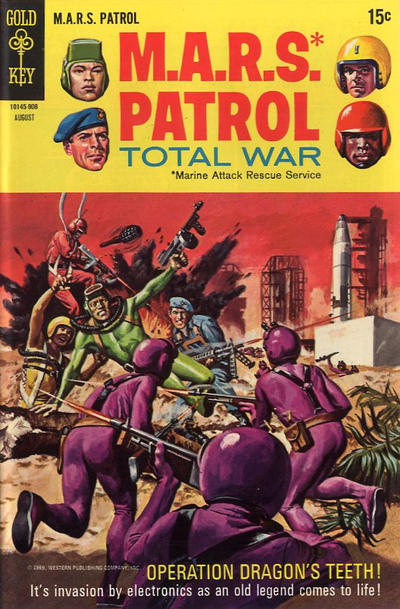 |
I found a nice copy of M.A.R.S. PATROL: TOTAL WAR #10 (Gold Key comics, August 1969) at Wizard World on Friday. The cover art on this final issue is by George Wilson and I think it's great! The series began in 1965 and was originally entitled TOTAL WAR. This lasted for two issues (with terrific art by Wally Wood) before the title was changed to M.A.R.S. PATROL: TOTAL WAR for the next eight issues. M.A.R.S. by the way, stood for Marine, Attack, Rescue and Service and each letter in that acronym corresponded to one of the four primary color-coded (red, blue, yellow and green) fighting men that starred in each issue. The four men were a racially diverse team with one member an African American, and another an Asian American. The men fought against the purple clad soldiers of an enemy force that had invaded North America. M.A.R.S. PATROL offered realistic combat action with a futuristic science fiction flair. I was nine-years-old when I bought that first issue of TOTAL WAR. I flat out loved this series from the get go and when I found this beauty at a fair price at the convention, I had to have it. Great stuff! |
WIZARD WORLD AUSTIN COMIC CON TREASURES 2
 |
I didn't know that any toy company had ever produced an action figure of Kamandi. But I found this at Wizard World and just had to have it. The figure, based on the title character of Jack Kirby's magnificent sf/adventure series KAMANDI: THE LAST BOY ON EARTH was made by Mattel for the Walmart exclusive line of DC Comics 75 Years of Super Power action figures. I collect action figures based on Jack Kirby (my all-time favorite comic book artist) characters. The dealer wanted twenty bucks for this baby but he let me have it for fifteen. Kamandi now has a place of honor on one of my bookshelves alongside other action figures based on Kirby DC characters. |
"AND YOUR CHICKS FOR FREE"
 |
I finished reading MONEY FOR NOTHING by Donald E. Westlake Friday morning before heading off to Wizard World Austin Comic Con. This 2003 novel is classic Westlake: a suspense thriller leavened with just the right amount of comedy. The plot sounds like something straight out of the Hitchcock playbook. An innocent man, Josh Redmont, gets a check in the mail in the amount of $1,000.00. The name on the check is "United States Agent". Josh does his best to find out who this mysterious benefactor is but to no avail. He deposits the check in his bank account. The check clears and Josh is one thousand dollars richer. The next month, another check arrives, in the same amount, from the same sender. Josh deposits the check as he does all of the subsequent checks he receives in this manner over the course of several years. He's now a family man with a wife and young child and a job at a New York City advertising agency. One day he meets a strange man who tells him that he's with "United States Agent" and it's time that Josh starts earning all of the money that he's been sent. Josh, of course, has no idea what's going on but it's soon revealed that he was paid to be set up as a sleeper agent by foreign agents who are now ready to "activate" Josh in a nefarious assassination plot that will involve the shooting of a foreign head of state at a ceremony in Yankee Stadium. Josh's wife and son are held hostage and his apartment becomes a storage depot for crates of AK-47s, foreign military uniforms and one Tina Pausto, a stunning Mata Hari wannabe. Josh has one ally in this insane tumble down the rabbit hole, Mitchell Robbie, an over-the-top actor from a hole-in-the-wall off-off-off Broadway theater who is also a sleeper agent of "United States Agent". Can Josh and Mitch outwit the professional killers they're mixed up with, clear their names, prevent the assassination and rescue Josh's family? What do you think? Westlake spins a good yarn here. He keeps things moving at a good clip and while parts of the novel are dark and sinister, the scenes with Mitch and his fellow players provide good comic relief. Josh and Mitch make a good "odd couple" as they must work together to save the day. MONEY FOR NOTHING is a good, fun read. If you're a fan of Westlake, you know what to expect. If you're not, give MONEY FOR NOTHING a try and see why Westlake has been called the master of the comic crime novel. |
Saturday, October 4, 2014
WIZARD WORLD AUSTIN COMIC CON TREASURES 1
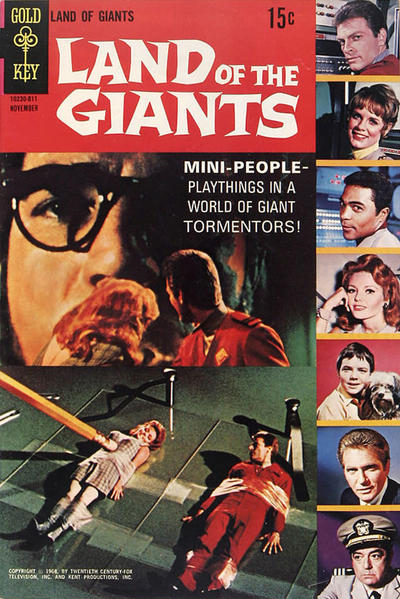 |
Pictured here is LAND OF THE GIANTS #1 (November, 1968), a Gold Key comic book based on the Irwin Allen produced television series of the same name. The series ran on ABC-TV on Sunday nights from September 1968 to September 1970. I bought this beauty at Wizard World Austin Comic Con yesterday. More treasures to come, plus a longer post about the entire Comic Con experience (good and bad). |
Monday, September 29, 2014
MIGHTY SAMSON
 |
When I was a kid (and boy howdy, just how many of these blog posts have started out with those exact same words? I'm thinking about renaming this blog to "When I Was A Kid". But I digress....) there was a comic book entitled MIGHTY SAMSON. Published by Gold Key comics beginning in 1964, the series took place in a post-apocalyptic New York City, now named "N'Yark" by the handful of humans living there. Among the humans was the elder scientist/wise man Mindor (who was always drawn by artist Frank Thorne to resemble actor Anthony Zerbe), his oh-so-lovely daughter Sharmaine and the hero of the book, the Mighty Samson, a one-eyed, animal-skin-wearing super-strong man. The series lasted 32 issues, which was a pretty good run for an original Gold Key title back in the day. It ended in 1982. The early issues featured stories by Otto Binder and artwork by Frank Thorne (yay!) and Jack Sparling (ugh!). Thorne's expressive, baroque, slightly rococo style was a joy to look at, at least it was for my young (and now old) eyes. But Jack Sparling's artwork, on whatever comic book he worked on, always struck me as ugly and unpleasant. Jack himself may have been one helluva guy but his artwork? Remember the movie MY LEFT FOOT? I think it was a documentary about Sparling's drawing method. MIGHTY SAMSON was a rollicking sf/adventure series with Samson, Mindor and Sharmaine encountering various mutated beasties and tribes of other human survivors in the ruins of New York and the wastelands of the Eastern Seaboard. It was a fresh and exciting concept and I loved it.  Recently, Dark Horse Comics acquired the rights to once again produce a regular MIGHTY SAMSON comic book. The first four issues of the series have been collected in MIGHTY SAMSON: JUDGMENT (pictured above) which I read the other day. The script by Jim Shooter extrapolates and expands the basic Samson set up by telling the story of two warring tribes of humans, one in New York City, the other in New Jersey. There's all sorts of political intrigue and power struggles along with bloody battles and the requisite mutated monsters. Into this conflict plops Might Samson who begins playing both ends against the middle and ends up in control of the New York tribe by the end of the story arc. Mindor and Sharmaine are along for the ride along with a number of supporting characters (good and bad). The artwork by Patrick Olliffe is very loose and sketchy looking in a number of places. It's not bad but it's not Frank Thorne. I enjoyed reading MIGHTY SAMSON: JUDGMENT for the most part. It's a fresh spin on a venerable character and the story was well plotted and complex enough to keep me turning the pages. I didn't like it well enough to want to seek out other Dark Horse issues of MIGHTY SAMSON however. Nope, it just made me want to dig out some Gold Key issues of MIGHTY SAMSON (I have several) and take a stroll down a disaster devastated and mutant monster populated memory lane. |
Wednesday, September 24, 2014
TARZAN/CARSON OF VENUS
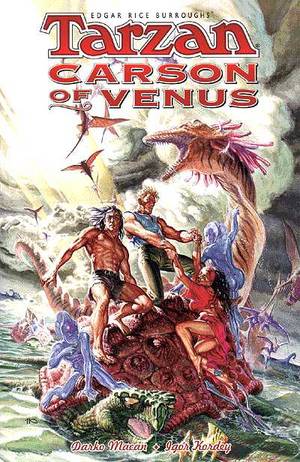 |
I picked up this beauty in a recent trade with a fellow comic book collector (thanks Nelson!). It's the Dark Horse trade paperback collection of the four-issue series TARZAN/CARSON OF VENUS originally published in 1999. I'm a fan of both of these characters although I must admit I've absorbed much more material featuring Tarzan (movies, books, comics) during my life than I have Carson of Venus. I read one of the original ERB novels years ago and I've got all of the books in the series on my bookcase shelf but the character hasn't had nearly as much exposure as Tarzan or John Carter of Mars. There was a short lived Carson of Venus comic book series back in the 1970s. It ran as a back up in issues of DC Comics' KORAK, SON OF TARZAN series. The stories were beautifully illustrated by Mike Kaluta (who also did superlative work on DC's THE SHADOW series from the same era). The Dark Horse series finds Tarzan transported to Venus (in much the same way John Carter traveled to Mars and back). There, he meets Carson and they have a rip-roaring adventure. It's pretty standard stuff and you either dig this type of pulp interplanetary adventure yarn or you don't. Me? I loved it. The script is by Darko Macan and the artwork is by Igor Kordey. Kordey's work is an amalgamation of Kaluta's art deco style and the work of underground comic book legend Rich Corben (especially on characters' faces). I know. Sounds weird. But it works. I enjoyed TARZAN/CARSON OF VENUS. If you're a fan of either character or the works of ERB in general, check it out. You won't be disappointed. |
Sunday, September 21, 2014
DAREDEVIL: FATHER
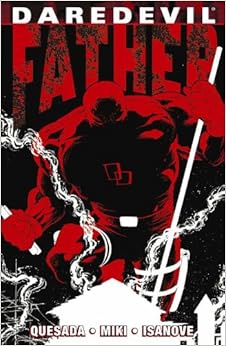 |
There's so much emotional baggage to be found in DAREDEVIL: FATHER, that buyers should receive a matched set of two pieces of luggage when they purchase this book. One suitcase should read "Daddy", the other, "Eyes". Those are the two motifs that dominate DAREDEVIL: FATHER, a six-issue mini series written and illustrated by Joe Quesada. The series was originally published in 2006. I read the hardcover collection of the material yesterday and I must confess that I rather enjoyed it. It's not the best Daredevil story I've ever read but it's certainly not the worst. Matt Murdock agrees to represent Maggie, a young married woman who has cancer due to exposure to toxic waste generated by a local municipality. There's also a serial killer operating in New York. Nicknamed "Socket Johnny", the killer removes the eyeballs of the victims before killing them. Oh, and there's also a new team of super powered individuals, The Santerians, on the scene. Almost all of these plot elements are connected in some way but it takes Matt a long time to finally figure out just what exactly is going on. Hint: one of these narrative threads is a red herring. The four main characters, Matt, Maggie and Sean (her husband) and NeRo (a mysterious young media star) all have major father issues. and two of the three characters have backgrounds that directly relate to Matt's childhood. Quesada's artwork is powerful and dynamic. In some scenes he appears to be channeling Frank Miller. In other places, his Daredevil looks more like Dare-Hulk, a massive, heavily muscled figure that doesn't quite jibe with the trim and graceful gymnast physique that is usually associated with the character. Bottom line: DAREDEVIL: FATHER is a well executed Daredevil story. It's got a nice mystery plot with a surprise ending that I didn't see coming. It's definitely worth reading if you're a fan of the character, Joe Quesada or both. Thumbs up. |
Saturday, September 20, 2014
PROJECT PENDULUM
 |
I'm a sucker for a good time travel story. Always have been. Always will be. So when I stumbled across a paperback copy of Robert Silverberg's PROJECT PENDULUM in a thrift store the other day, I couldn't resist buying it. After all the price was right. A buck. I've read other books by Silverberg and I've enjoyed every one of them. He's one of the greatest science fiction writers of all time. In PROJECT PENDULUM, twin brothers Eric and Sean (one a physicist, the other a paleontologist) are chosen as the first test subjects of a time travel device. The mechanism, which is composed of a man-made, extremely small black hole set in opposition to an equal size, artificial "white hole", will send Eric into the future and then back into the past and then the future, and so on, at gradually increasing intervals of time from where the experiment begins at Time Zero in 2016. Brother Sean will likewise travel through time on a swinging pendulum of shunts, first into the past, then the future, then the past, and on. When one brother is in the past, the other is in the future, each progressing farther and farther into both the past and the future on each respective swing. When both brothers reach Time Ultimate, the absolute outermost edges of time past and future, they began to move back to Time Zero in swings in the other direction with each twin now experiencing the various time periods and situations that his brother previously encountered. It's a great idea, a terrific concept and it's extremely well executed. Silverberg never lets us get lost along the way of relating these parallel, separate trips through time. But the book is sorely lacking in any character development or suspense. Each chapter is short and things move along at a brisk pace. In fact, I finished reading this book (210 pages) in less than two hours. Each time period visited (past and future) made me want to read a longer story set in each year the brothers visit. In short, I wanted more, much more. PROJECT PENDULUM isn't a bad book. But it's not an entirely satisfying one either. It's more a novella built around a really great concept. The bones of a great story are there but there's not much meat on them. |
Monday, September 8, 2014
YOU SAY YOU WANT A REVOLUTION
 |
I bought this one at Half Price Books on Saturday and read it in one sitting later that afternoon. Gotta admit, I've got mixed feelings about THE SHADOW VOLUME 2: REVOLUTION. Let's start with the good stuff. Cover art by Alex Ross is always a plus. How many covers has he done for Dynamite over the last few years? Glad to see they're keeping him busy as he is, in my opinion, the best comic book cover artist currently working. The folks at Dynamite are smart enough to recognize that The Shadow works best when the material is kept as a period piece. The Shadow belongs to the '30s & '40s, not the 21st century. So, kudos there for the '30s setting. Now comes the not so good. For some reason, it's been decided that the "power to cloud men's minds" that The Shadow employed on the radio program of the same name is an actual, bonafide super power of some sort. It's also a power that The Shadow is capable of losing. I don't like this. Clouding men's minds worked well on the radio, a medium in which the listener's imagination had to fill in the gaps and make the stories come fully alive. Here, The Shadow is like Obi Wan-Kenobi whispering "these aren't the droids you're looking for." I'm beginning to think that it's an editorial mandate at Dynamite that the interior art in all of their comics be inferior to the cover art. In addition to the work of Alex Ross, this volume has a cover gallery of alternative and variant covers of the six issues reprinted within and the artwork on all of them is uniformly superior to the actual story art. And we get a mixed bag of stories to boot. The title arc, "Revolution" is a four-parter in which The Shadow finds himself in the middle of the Spanish Civil War where he teams up with no less a historic personage than George Orwell to do battle against the insane El Rey and his vicious, female second-in-command, The Black Sparrow. The script is by Victor Gischler, with art by Aaron Campbell. The story is so-so and the art is serviceable if unspectacular and rather generic. "Revolution" is book-ended by two done-in-one, stand alone stories, each of which are better than the longer main feature. The first story is again scripted by Victor Gischler with much better art by Jack Herbert. It's the best looking story in the whole package. The final story is another Gischler script with passable art by Giovanni Timpano. I give this one a B. I love The Shadow and I'm always happy to read new material featuring the character. I love the fact that it retains the '30s milieu of the pulp classics. The covers are all nice but the stuff behind those covers could have been better. |
Thursday, September 4, 2014
PARKER
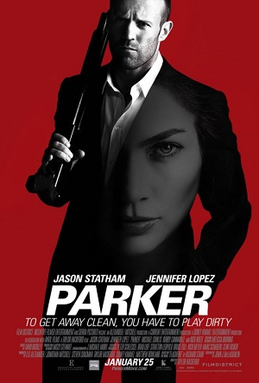 |
How's this for serendipity? I finished reading FLASHFIRE, a Parker novel by Richard Stark a couple of weeks ago. I loved it and posted a very positive review of the book here on my blog. I mentioned in the post that the novel had been adapted into the film PARKER (2013) and that I would be on the lookout for it. I was in Walmart the other day, browsing through a giant bin of Blu-Ray DVDs and what did I find? Yep, you guessed it, PARKER. I bought it and watched it yesterday. Overall, the film was a fairly faithful adaptation of the novel. Oh, sure, things are changed a bit. There are characters in the film that weren't in the book (including an ancient looking Nick Nolte as Parker's mentor). Nolte, who would have been a not-bad choice to play Parker in a film forty years ago, has a few scenes with star Jason Statham early in the film and then disappears entirely from the rest of the movie. Jason Statham makes a serviceable Parker. He's big, well-built and tough with rugged good looks. But he's got an accent which Parker doesn't have in the books. He's not my ideal version of Parker. That remains the great Lee Marvin, who played the Parker analogue "Walker" in John Boorman's magnificent POINT BLANK (1967). But since Marvin is long gone, Statham will fill the part nicely for the 21st century. Jennifer Lopez is an interesting choice to play Leslie, the greedy real estate agent who becomes Parker's partner-in-crime. In the book, Leslie wasn't a Hispanic woman but Lopez does a good job bringing a deft touch of light comedy to the role and she's certainly easy on the eyes. Parts of the film (scenes and dialogue) are lifted verbatim from the book. The heist at the beginning of the film is staged at the Ohio State Fair and is on a much larger scale than the robbery that opens the book. Still, the screenplay follows the general gist of the novel fairly well. Characters and scenes are compressed and changed slightly to make everything more connected than it is in the book. And the violence is off the charts. There are several brutal fight scenes and gun battles but that's what we've come to expect from a modern action film. Director Taylor Hackford does a good job of keeping things moving. PARKER is a gritty crime film that unfortunately bombed at the box office. It was released early in the year which is a traditional dumping ground for films that studios don't have much hope for. The fact that it underperformed at the box office means it's unlikely we'll see another Parker adventure with Statham in the lead. That's a pity because I'd certainly love to see another one. If you've read FLASHFIRE, you'll enjoy watching PARKER and playing the inevitable book-to-film comparison game. As always, the book is better but if you're a fan of the series, you'll enjoy the film. |
Wednesday, September 3, 2014
BACKFLASH
 |
Today's short essay topic: describe how you would plan and execute a robbery of a casino ship in the middle of the Hudson river. You've got to get and getaway with over $300,000 in cold, hard cash. Oh, and security measures will not allow any guns to be brought on board. Ready? Go. That's the problem facing super thief Parker in BACKFLASH (1999), number 18 in the series of crime novels by Richard Stark (in reality Donald Westlake). I finished reading this one yesterday evening. It's one of those books where once I got to a certain point in the narrative, I absolutely could not stop reading. I inhaled the last one hundred pages in one sitting and believe me, I couldn't turn the pages fast enough. The book is divided into three acts. The first focuses on the planning of the heist and the recruitment of the players in the caper. The middle third is the actual execution of the robbery. It's an ingenious plan involving a fake politician and his two bodyguards, an invalid girl in a wheelchair and her chauffeur. The final act is the getaway which, in the tradition of all great caper stories, goes wrong when various outside players decide to cut themselves in for a piece of the action. It's up to Parker to tie up all of these loose ends and as he does so the body count starts mounting. BACKFLASH is wonderfully entertaining, a fast paced, gritty crime thriller in which we're solidly on the side of the bad guys. We want Parker and his gang to be successful and get away with the money but Stark has to put them through the wringer before it's all over. Highest recommendation. |
Monday, September 1, 2014
DARKMAN
 |
Hey kids! Let's play spot the influences in Sam Raimi's DARKMAN (1990), which I watched yesterday. This B-movie pulp adventure yarn is part classic Universal Studios monster movie, part Stan Lee-Jack Kirby Silver Age Marvel super-hero comic book. It's a wonderfully entertaining mash up that features nods to The Invisible Man, The Phantom of the Opera, Dr. X, The Shadow, The Incredible Hulk and The Chameleon (the old Spider-Man foe). Is it a great film? Hell no. But it is a ton of fun to watch. DARKMAN was director Sam Raimi's first big budget film for a Hollywood studio (appropriately, Universal). Raimi made a name for himself as a genre master with his break out hit THE EVIL DEAD in 1981, followed by CRIMEWAVE (1985), and EVIL DEAD 2 (1987). With DARKMAN, his fourth full length feature film, Raimi put his kinetic, over-the-top visual sensibilities on display in a tale of dark revenge. Liam Neeson (before he became a bonafide action film star) is a scientist experimenting with artificial flesh. His girlfriend, Frances McDormand, is a lawyer standing in opposition to a crooked real-estate developer played by Colin Friels (a dead ringer for University of Alabama head football coach Nick Saban). Larry Drake is Durant, one of Friels goons. In order to put the squeeze on McDormand, Durant and his men beat up Neeson and blow up his lab, leaving the good doctor for dead. That was their first mistake. Neeson survives the explosion but he's horribly disfigured. He somehow manages to salvage most of his lab equipment and, setting up shop in an abandoned foundry, sets out to put his artificial skin technology to use in exacting his revenge against Durant and his henchmen. There are some well-staged action sequences (including a helicopter chase with Neeson swinging on a cable beneath one of the choppers) before the final showdown at a construction site. At the end of the film, Neeson disappears into a crowd of people, dubs himself "Darkman" and appears on screen as Bruce Campbell (Raimi's go-to guy) in the final shot of the film. DARKMAN is all hyperbolic, pulpy fun. Produced one year after Tim Burton's seminal BATMAN (1989), DARKMAN employs a BATMANesque score by composer Danny Elfman. Raimi further cemented his reputation as a comic book film auteur with his three Spider-Man films: SPIDER-MAN (2000), SPIDER-MAN 2 (2004) and SPIDER-MAN 3 (2007). DARKMAN did well at the box-office, prompting a slew of spin-offs and tie-ins including a Marvel Comics series, video games and action figures. Two direct-to-video sequels followed, THE RETURN OF DURANT (1994) and DIE, DARKMAN, DIE (1996). I saw DARKMAN in the theater when it was first released and loved it. I hadn't seen it since then until I watched it yesterday afternoon when I enjoyed it again all over. Recommended for both horror film and comic book fans. |
Subscribe to:
Posts (Atom)

